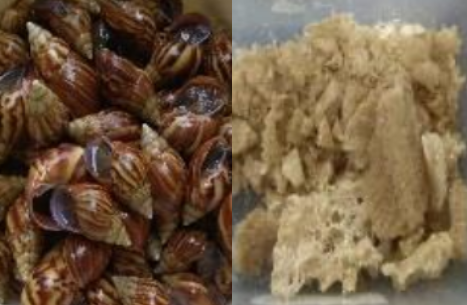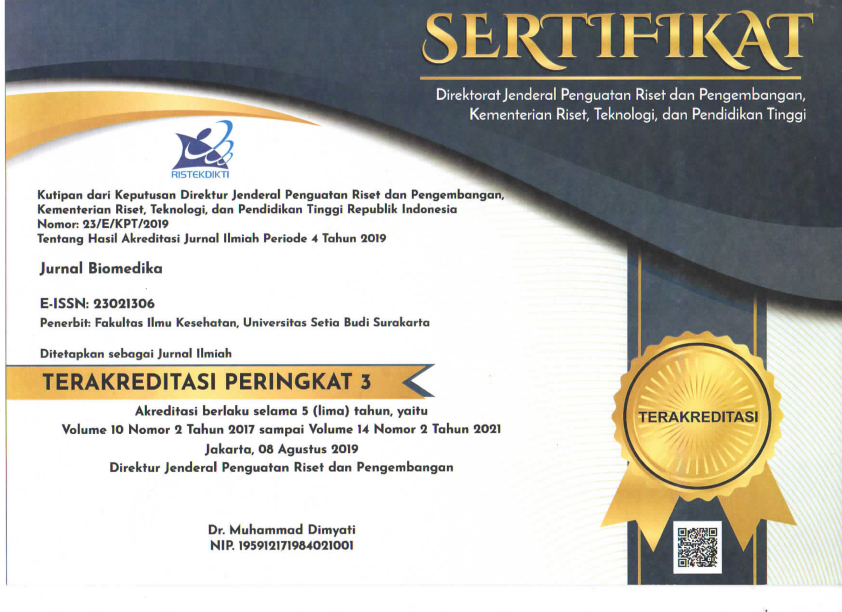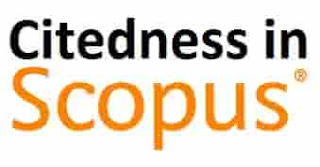The Potential and Effectiveness of Snail Seromucoid and Chitosan as Bioimmunostimulators
Abstract
The host's cellular immune response plays an important role in the process of eliminating microorganisms that cause infection. Substances that can stimulate an increase in the immune response are called immunostimulators. Snail seromucoid contains bioactive compounds such as glycans, peptides, glycopeptides and chondroitin sulfate. Chitosan as an antimicrobial agent can be used in the biomedical field because chitosan has a number of hydroxyl groups (OH) and amine groups (NH2). The research objective was to determine the potency and effectiveness of snail seromucoid and chitosan as bioimmunostimulators. The research method is based on laboratory experimental results with the research stages, namely the analysis of the effectiveness of seromucoid and chitosan on lymphocyte proliferation. The results of the one way ANOVA analysis showed a p value of 0.000 so that there was a significant effect between the treatment groups, namely the effect of giving chitosan 65 ug/ml; snail mucus 65 ug/mL and a combination of chitosan (65 ug/mL) and snail mucus (65 ug/mL) ratio of 1:1, can increase lymphocyte proliferation optimally. This shows that snail mucus, chitosan and their combination in a 1:1 ratio are effective as BRM (Biological Response Modifier). It is hoped that the contribution of the results of this study can be further developed in the bioformulation of snail seromucoid preparations and chitosan as therapeutic agents for infectious diseases, including Acute Respiratory Distress Syndrome (ARDS), Tuberculosis and other diseases.
References
Anggraini D, Sri Darmawati, Endang T.W. M., (2018). Protein profile and anti-microbial power of snail slime (Achantina fulica) against Methicillin Resistant Staphylococcus aureus (MRSA). Proceedings of the Unimus Student National Seminar 1, pp. 73 - 77
Berniyanti T. and Suwarno,S. (2007). Characterization of local isolate snail slime (achasin) protein as an antibacterial factor. Journal of Veterinary Media, 23 (3) pp. 139-144
Benkendorff, K., Rudd, D., Nongmaithem, B. D., Liu, L., Young, F., Edwards, V., Avila, C., & Abbott, C. A. (2015). Are the traditional medical uses of muricidae molluscs substantiated by their pharmacological properties and bioactive compounds?. Marine drugs, 13(8), 5237–5275. https://doi.org/10.3390/md13085237
Bislimi, K.., Halili, J., Mazreku, I., Osmani, F., Halili, F. (2013). Comparative analysis of some biochemical parameters in emolymph of garden snail (Helix pomatia L.) of the Kastriot and Ferizaj Regions, Kosovo. International Journal of Engineering and Applied Sciences 4 (6) pp 11-18 www.eaas-journal.org
Bonnemain B. (2005). Helix and Drugs: snails for western health care from antiquity to the present. Evidence-based complementary and alternative medicine : eCAM, 2(1), 25–28. https://doi.org/10.1093/ecam/neh057
Dang, V. T., Benkendorff, K., Green, T., & Speck, P. (2015). Marine snails and slugs: a great place to look for antiviral drugs. Journal of virology, 89(16), 8114–8118. https://doi.org/10.1128/JVI.00287-15
Dolashka, P., Dolashki, A., Van Beeumen, J., Floetenmeyer, M., Velkova, L., Stevanovic, S., & Voelter, W. (2016). Antimicrobial activity of molluscan hemocyanins from helix and rapana snails. Current pharmaceutical biotechnology, 17(3), 263–270. https://doi.org/10.2174/1389201016666150907113435
El Mubarak, M. A., Lamari, F. N., & Kontoyannis, C. (2013). Simultaneous determination of allantoin and glycolic acid in snail mucus and cosmetic creams with high performance liquid chromatography and ultraviolet detection. Journal of chromatography. A, 1322, 49–53.
https://doi.org/10.1016/j.chroma.2013.10.086
Etim, L.B., Aleruchi, C., & Obande, G.A. (2016). Antibacterial properties of snail mucus on bacteria isolated from patients with wound infection. British microbiology research journal, 11, 1-9. https://doi.org/10.9734/BMRJ/2016/21731
Harti, A.S, Puspawati, N., Putriningrum, R. (2019). Antimicrobial bioactive compounds of snail seromucoid as biological response modifier immunostimulator. Journal of Microbiology Indonesia, 13 (2), pp 56-63.
https://doi.org/10.5454/mi.13.2
Harti, A.S., Estuningsih, E., Kusumawati, H.N., Siswiyanti, S., and Setyaningtyas, A., (2016 a). In vitro synergistic effect of snail slime and chitosan against Staphylococcus aureus. International Journal of Pharma Medicine and Biological Science, 5 (2), pp. 137-141. https://doi.org/10.18178/ijpmbs.5.2.137-141
Harti, A.S., Sulisetyawati, D.S, Murharyati, A., Oktariani, M., Wijayanti, I.B. (2016b). The effectiveness of snail slime and chitosan in wound healing. International Journal of Pharma Medicine and Biological Science 5 (1), pp 76-80. https://doi.org/10.18178/ijpmbs.5.1.7680
Harti, A.S., Murharyati, A., Sulisetyawati, D.S., Meri Oktariani, M. (2018). The effectiveness of snail mucus (achantina fulica) and chitosan towards lymphocyte proliferation in vitro. Asian Journal Pharmaceutical and Clinical Research; 11 (3), pp. 85-88. https://doi.org/10.22159/ajpcr.2018.v11s3.30041
Huda M., and Marhamah, M. (2016). Effect of snail mucus (Achantina fulica) on the growth of Gram-positive and Gram-negative bacteria. Journal of Health Analyst . 5 (2), pp. 547 - 555 http://dx.doi.org/10.26630/jak.v5i2.461
Ibrahim, K. A., El-Eswed, B. I., Abu-Sbeih, K. A., Arafat, T. A., Al Omari, M. M., Darras, F. H., & Badwan, A. A. (2016). Preparation of chito-oligomers by hydrolysis of chitosan in the presence of zeolite as adsorbent. Marine drugs, 14(8), 43. https://doi.org/10.3390/md14080043
Greistorfer, S., Klepal, W., Cyran, N., Gugumuck, A., Rudoll, L., Suppan, J., & von Byern, J. (2017). Snail mucus - glandular origin and composition in Helix pomatia. Zoology (Jena, Germany), 122, 126–138. https://doi.org/10.1016/j.zool.2017.05.001
Naoshi, K., Yasusato, S., Masakichi, S., and Masao,K. (2005) Preparation of chito-oligosaccharides by two step hydrolysis. Chitin and Chitosan Research Journal . 11 (2). pp. 170-171.
Nakashima, M., & Iohara, K. (2014). Mobilized dental pulp stem cells for pulp regeneration: initiation of clinical trial. Journal of endodontics, 40(4 Suppl), S26–S32. https://doi.org/10.1016/j.joen.2014.01.020
Nantarat, N., Tragoolpua, Y., & Gunama, P. (2019). Antibacterial activity of the mucus extract from the giant african snail (Lissachatina fulica) and golden apple snail (Pomacea canaliculata) against pathogenic bacteria causing skin diseases. Tropical Natural History, 19(2), 103–112. Retrieved from https://li01.tci-thaijo.org/index.php/tnh/article/view/150872
Rosanto,Y.B., Hasan, C.Y., Rahardjo R. and Pangestiningsih, T.W. (2021). Effect of snail mucus on angiogenesis during wound healing F1000Research 2021, 10:181, pp. 1-17 https://doi.org/10.12688/f1000research.51297.2
Sallam, A.A.A, El-Massry, S.A., and I.N. Nasr, I.N. (2009). Chemical analysis of mucus from certain land snails under Egyptian conditions. Archives of Phytopathology and Plant Protection. 42(9) pp.874-881. DOI: 10.1080/03235400701494448.
Suwannatri, K., Aiporn, S., Paitra. T., Jariya,U.W., Sirikachorn ,T., Cinzia,C. et al. (2016) Differential protein expression in the hemolymph of bithynia siamensis goniomphalos infected with Opisthorchis viverrini. PLOS Neglected Tropical Disease Journal . 10 (11), pp. 1-20. https://doi.org/10.1371/journal.pntd.0005104
Sutanto, Y. S., Sutanto, M., Harti, A. S., & Puspawati, N., 2020. The sensitivity test of Mycobacterium tuberculosis isolates from suspect tuberculosis patients to the seromucous of snail and chitosan as an alternative anti-tuberculosis drug. Asian Journal of Pharmaceutical and Clinical Research, 13(10) pp. 44-49. https://doi.org/10.22159/ajpcr.22020.v22113i22110.38266
Sutanto, Y.S. Sutanto, M., Harti, A.S., 2021. Anti-tuberculosis drugs against the resistance level of Mycobacterium tuberculosis isolates. KEMAS, 17 (1) 14-23. https://doi.org/10.15294/kemas.v17i1.24158























